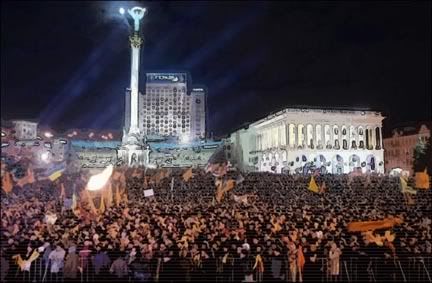Adam Larson/Caustic Logic
Guerillas Without Guns/Chapter 9
Posted 4/23/07
An ancient center of Christianity, Armenia was made an SSR around Christmas of 1920. Memories of Soviet-era repression of the Armenian Church did not keep the former SSR from signing on to Russia’s CIS at independence, and later the CSTO as Russia’s only remaining close partner in the Caucasus. But the government at Yerevan also has created a full market economy, allowing high economic freedom and low corruption by CIS standards, and has even gained membership to the WTO as of 2003. Robert Kocharian, second President since independence, has ruled from Yerevan since 1998. The Armenian election process is often criticized in the West, [1] but opposition parties are allowed, and have formed into the Justice Bloc coalition.
Again the transition to independence here was not smooth, with the early 90s witnessing a fierce Armenia-Azerbaijan war over the territory of Nagorno-Karabakh. The conflict claimed over 20,000 lives before it was ended with a Russian-brokered cease-fire and OSCE-brokered peace talks in 1994. Nikolai Kovalyov, former head of Russia's FSB, insisted in early 2004 that Armenian activists had trained alongisde Pora and Kmara kids at the “U.S.-funded camps in Serbia” [2] Following Ukraine’s Orange Revolution, Western and Russian media predicted that Armenia could be the next setting for a “color revolution.” Some Armenian media outlets went so far as to suggest names for that would-be revolution, including “The Apricot Revolution” and “The Peach Revolution.” [3]
It started with Armenia’s presidential election in March 2003 followed by parliamentary elections in May; big changes were possible just months before the Rose revolution would finally announce the opening of the color phase in neighboring Georgia. Widespread complaints about voting irregularities and general discontent helped opposition parties, but they failed to “fully capitalize” on this, and the protest campaign fizzled. Again in 2004 an upheaval as planed, but the authorities resorted to tough tactics like illegally blocking the bus system into Yerevan to prevent masses of opposition supporters from joining the rallies there. [4]
Opposition parties were predicting big changes again in April 2005 as parliamentary elections again drew near. But analysts pointed out their organizational weaknesses, lack of a charismatic leader comparable to Saakashvili, and the competition and bickering between the challengers for the slot - Artashes Geghamian and Stepan Demirchian. They jointly announced a boycott of parliament in early 2004, hoping the progressives absence from the government would gain them wider popular support. Instead, one year later EurasiaNet explained, “the boycott appears to have only denied the opposition an opportunity to express their opinions on the national stage.” Given the failures of the past, and the relative lack of urgency there, the population was not enthusiastic about revolution in 2005. “The peach has not matured yet,” the Yerevan-based daily Aravot concluded. The 2005 campaign fell apart and there are no new elections until 2007 – they missed their chance for the time being. [5]
Sources:
[1] "Armenia." Wikipedia. As modified on September 3 2006. http://en.wikipedia.org/wiki/Armenia
[2] Feinberg, Leslie. “Washington and the coup in former Soviet Georgia.” Worker’s World. January 22, 2004. Accessed at: http://www.workers.org/ww/2004/georgia0122.php
[3], [4], [5] Khachatrian, Haroutiun. ARMENIA’S OPPOSITION: IN SEARCH OF A REVOLUTION Eurasia Insight. April 19 2005. http://www.eurasianet.org/departments/insight/articles/eav041905.shtml
Monday, April 23, 2007
ARMENIA: NOT RIPE FOR REVOLUTION
Labels:
Apricot Revolution,
Armenia,
Azerbaijan,
CIS,
CSTO,
Kocharian,
Nagorno-Karabakh
Subscribe to:
Post Comments (Atom)


No comments:
Post a Comment